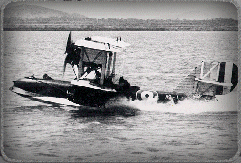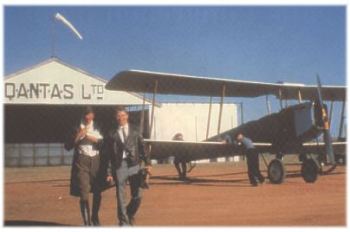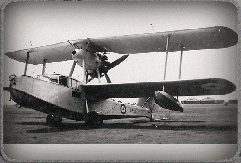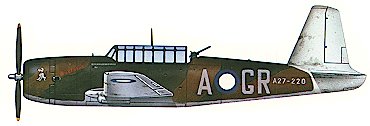

CATALINA & CORAL SEA MEMORIAL MUSEUM
BOWEN AND IT'S FLIGHT WITH THE AVIATION WORLD
© L. Menadue 1996
1 Coral Sea and Catalina Memorial.
2 101 Fleet Co-Operation flight.
3 Bowen's first plane.
4 Miscellaneous Histories.
5 Tables of reference.
Section 1
CORAL SEA and CATALINA MEMORIAL MUSEUM
Bowen
Queensland, Australia.
Location : Bowen airport, approximately 5 minutes north of Bowen on the Bruce Highway.
Subject : Coral Sea naval battle and associated land based support bases at Bowen, North Queensland, circa 1942.
Opened :7th May, 1992.
The Coral Sea and Catalina Memorial Museum was a project bought about by the 50th Anniversary Celebrations, commemorating the Coral Sea battle of 1942. Although celebrations were held all over Australia, focusing mainly on Townsville, North Queensland, some Bowen citizens felt that although mainly a support base during the war, there should be some form of memorial to those who lost their lives during this battle, as well as those who returned home. During the war, several raids into the northern islands were launched from Bowen, and little is recorded regarding the town's role in the defence of Australia.
With the help of Laurie Menadue, Derek Jarmaine and Alan Woodfield, LeRoy Billings set about acquiring a location and funds to erect a memorial. As we progressed, we determined that we should use the best qualifications available to the four of us and the idea of a scaled display of the period was decided to be most suitable. Derek, Alan and Laurie were avid modellers, and a location at the Bowen Airport in the form of a disused building was soon acquired. The Bowen Shire Council agreed to allow the project to be built there, and soon after, funding through the Bowen Chamber of Commerce was arranged. Several businesses also assisted with support in the way of materials and discounts.
Measuring some 10 metres by 5.4 metres this building seemed destined to be a fitting choice considering its past use as an airport terminal and lounge from the days when commercial aircraft joined Bowen to destinations in the south. The building was erected by Sir Reginald Ansett for use by Ansett and when the project commenced, it still retained the wallpaper of aircraft images used long ago. Being a lounge it was fitted out with large glass windows, and to accommodate our displays, these had to be covered over. This completed, the dioramas were drawn up with the team settling on five different scenarios. The dioramas are as follows:
1 - USS Lexington model in 1/72 scale.
2 - Bowen Slipway and hard standing area in 1/72 scale.
3 - Diorama depicting the loss of a PBY 5 Catalina off Bowen in 1/72 scale.
4 - Diorama depicting the loss of a Seagull V off Bowen in 1/72 scale.
5 - A sectional diorama depicting the Bowen Airfield during this period in 1/72 scale.
The Coral Sea and Catalina memorial Museum is maintained under the auspices of the Bowen War Memorial Park Association Incorporated.
Diorama One : USS LEXINGTON - CV-2


(Photos - US Navy Photographs - US National Archives)
The diorama depicts a 12 feet 4 inch model of the "Lady Lex", believed to be the largest model of a ship on public display in Australia, with her complement of Douglas Dauntless, Douglas Devastator, and Grumman F4F-4 Wildcats, busying themselves preparing for the forthcoming assault against the Japanese Fleet. Unfortunately, while these aircraft were away trying to stop the Japanese Fleet, the Lexington was hit on the port side by two torpedoes from the Japanese aircraft. She was also hit by bombs. The explosion of several near misses resulted in rupturing the aviation fuel tanks, releasing vapour throughout the ship. Eventually a spark caused devastating internal explosions, causing her to be abandoned with the resultant loss of 216 lives of her 2951 crew. The "Lady Lex" was sunk by her own forces some six hours after the first hit. She was to fail to inflict any serious damage on her enemy, and her loss was a heavy blow to the Allied forces.
Hanging on the wall behind the USS Lexington are the flags of the two Allied nations of this conflict -United States of America and Australia.. The American flag is one flown during this period with the forty eight star upper quadrant.
Also displayed in this diorama are two PBY-5 Catalinas, A24-18 shot down on 4th May, with a loss of nine aircrew. This aircraft was piloted by Godfrey Hemsworth, whose brother Neville, also a WW2 RAAF veteran, dedicated the Museum on 8th May, 1942. The other aircraft is A24-20 shot down on 6th May with a loss of 9 aircrew. Both these aircraft were shadowing the approaching Japanese Fleet. A24-18 is credited with first locating the Fleet, and was subsequently ordered to identify and report back the size and content of the fleet. The plane did so and was not heard from again.
Diorama two: BOWEN SLIPWAY circa 1942.
This diorama shows the Catalina support facilities at Bowen, used by the Royal Australian Air Force, for the maintenance, by No 1 Flying Boat Maintenance Unit, of its amphibious fleet of Catalinas. The American Services were also using the facilities as needed. The diorama is centred around the hard standing which was the area for the general repair and maintenance. Two hangars were erected at the eastern end of the hard standing, to allow work to continue in inclement weather. Aircraft were armed while swinging at the buoy from a lighter. Ammunition was bought into the area by a railway line which ran between the two hangars. The RAAF had to replace the wooden slipway with a concrete one as the sea borers rendered the wood unsafe. The slipway extended out some 3,000 feet, to a point adjacent to the junction of the jetties.
When attack was imminent, or aircraft overfilled the hard standing, they were towed away to security at remote tie down areas. These were located at the end of Thomas Street and along Sinclair Street between William and George Streets.
The hard standing measured 179.7 m (589.5 ft) by 102.75 m(337.1 ft). The hangars measured 38.1 m (125 ft) long and 19.3 m (63.5 ft) wide. The slipway was 12.19 m (40 ft) wide. The hard standing was protected by a gun emplacement at the Thomas Street end, while along the railway line was the Engineering building.
A reminder of the reality of the people of the past is two imprints in the concrete. One in the concrete of the hard standing reflects on two Royal Australian Air Force Reserve members : R Anderson
W.H. Squire, a (or d) 5208, RAAF Res.
The other imprint found following the demolition of the hangars was an engraving : F J 1944 .
These details are still visible today as reminders of those who were here when the concrete was laid.
Bowen played host to Nos 11 and 20 Squadrons during the war. Number 20 Squadron commenced its move to Bowen in May 1942. During the early part of 1942, the squadron's main role was seaward reconnaissance throughout the entire New Guinea area and extending to the Solomon Islands, New Caledonia. As the year wore on, the squadron was tasked more frequently for night bombing missions. Detachments from the Bowen based squadron operated from Townsville, Cairns and Horne Island. In November, 1942, the squadron moved to Cairns. The Squadron was formed at Port Moresby on first August, 1941 and disbanded on twenty-seventh March, 1946.
Bowen has the distinction of being the furthermost southern location in Australia from which missions were launched during World War Two.
The slipway has had many a use, following the war, with the Port Denison Sailing Club being awarded custody. The slipway provides access for the local fishermen, while for some time the area was planned to become a marine slipway for boat maintenance servicing the Whitsunday Islands. The slipway was also host to a modern hovercraft on one occasion. Following a fire in one hangar, both were eventually demolished in the 1980s leaving only a flat concrete hard standing. For a while, coal was stored on one side of the hard standing, in readiness for shipping to the jetty via a moving conveyor. This was eventually removed once Abbott Point Bulk Coal Terminal began operations, some 40 kilometres north of Bowen.
Bowen still has many residents who worked on the aircraft of World War II, and even more memories of the period.
Diorama three : MEMORIAL TO THE CREW LOST ON CATALINA PBY-5 A24-24.
This memorial is dedicated to those who lost their lives on a flight aboard A24-24 off Bowen offshore from Queens Beach. The aircraft was returning from a sortie with several members of the Army on board when it clipped the water and crashed. The wing was torn off the pylon and a crew's engineer was thrown clear to survive. The other survivor, a gunner, was thrown out of the blister turret on the side of the aircraft.
While only small, this memorial recognises the cost of those live as well as reminding us of the other lives lost away from here. The nature of the work of the Catalina was such that there were some fifty percent loss of aircraft and some twenty nine percent loss of personnel in the first five months of the commencement of the conflict with Japan
Those who perished were:
Pilot Officer S. J. Porteous 410419 aged 25
Flying Officer P. Keens 416430 aged 26
Sgt. L. G. Dalgleish 12240 aged 30
Sgt. H. S. W. Thomas 427166 aged 20
Sgt. R. C. Ciglander 426048 aged 19
LAC A. J. Dent 20387 aged 23.
The following were members of AIF 2/7 General Hospital Australian Army Medical Corps.
Captain D. C. Whitfield VX47450 aged 32
Captain L. E. Tansey NX200513 aged 24
S/Sergeant L. H. Harrison VX38770 aged 24
Sergeant L. G. Fiske VX40288 aged 24
Private K. R. Walker VX124120 aged 19
Private I. G. Osborne VX124121 aged 19
Private D. Mc Laine VX126184 aged 19.
Lest We Forget
Diorama four : MEMORIAL TO THE CREW LOST ON
SEAGULL V A2-9.
Seagull V A 2-9 was lost off Stone Island in the Port Denison Channel in 1943. The aircraft had three crew on board and all perished. Salvage operations were difficult and resulted in three attempts to raise the wreckage.
A2-9 was received into the Royal Australian Air Force at 1 Aircraft Depot, 19th May, 1936 and went on charge to 5 Squadron in June that year. She was embarked on HMAS Canberra on 26th January, 1938. She transferred to HMAS Sydney in July, 1938. On 21st August, 1939 she went to 2 Aircraft Depot. On 16th September, 1940 she went to STF before going to 9 Squadron on 14th April, 1941 for detachment to HMAS Hobart. A2-9 was issued to QANTAS on 8th June, 1942 before returning to 9 Squadron on 10th January, 1943. Following the crash on 8th February, 1943 and subsequent salvage she was converted to spares on 23rd February, 1943.
Those who perished were:
Flight Lieutenant D. J. Hookings aged 26
Pilot Officer E. C. S. Sherwood - Seller aged 25
Lieutenant J. H. Mc Whae
Lest We Forget
Diorama five : BOWEN AIRFIELD circa 1942.
The Bowen Airfield situated beside the Bruce Highway south of the Don River, was host to many varieties of aircraft during the war period. Most numerous were perhaps the Supermarine Seagull Vs and Supermarine Walrus' of No 9 Squadron. These aircraft were employed during their stay in Bowen for reconnaissance, ferry flights re-supply as well as strike missions. The airfield consisting of two crossing runways and a large grassed field operated a control tower, communications centre, as well as several concrete ammunition huts. The aircraft were positioned at three points behind rock wall barricades.
Later in the war, Bowen was host to :
RAAF Station Bowen - 16/05/42 to 01/08/42.
No 22 Operational Base Unit - 01/08/42 to 10/10/43.
No 1 Flying Boat Maintenance Unit - 10/10/43 to 14/03/47
No 1 Aircraft Performance Unit - 21/01/44 to April 44.
(Special Duties Flight Detachment)
No 9 Squadron - 12/01/43 to 01/12/44.
No 9 (Fleet Co-Operation) Squadron - 01/01/42 to 13/02/44.
No 11 Squadron - May 42 to 11/11/42.
No 20 Squadron- 07/05/42 to 11/11/42.
No 43 (General Recon. Flying Boat) Squadron - 10/05/43 to 18/08/43.
No 42 Radar Station - 05/03/43 to 24/04/46.
No 114 Air Sea Rescue Flight (Detach) - 06/06/45 to 31/08/45.
Chemical Research Unit - 15/08/44 to 24/12/45.
MISCELLANEOUS NOTES.
The local museum has on display various artefacts collected and donated with respect to this particular era.
The Royal Australian Air Force sent a detachment from 31 Squadron to assist in the opening ceremonies, and assisted with a flyover of the memorial, as well as a flyover of a commemorative wreath laying service over the site of the crash of A24-24. The 31 Squadron Caribou was also open for public display.
Catalina veterans returned to Bowen for the opening.
As part of the opening of the Coral Sea and Catalina Museum, Australia Post approved a special cancellation stamp for use on the 8th May, 1992. Also especially created for the opening was Commemorative Envelope and folder.
Section 2
101 FLEET CO-OPERATION FLIGHT
The 101 Flight was sent to Bowen in 1926 to carry out an aerial survey of the Great Barrier Reef. The Flight was designed to operate from the aircraft tender HMAS Albatross which called into Bowen frequently. It could launch and recover the amphibians by crane but needed smooth water for these operations. The flying unit took up quarters in the Port Denison Sailing Club hall, located on the beach front in front of the power station. Headquarters was in an old drill hall, a curved roof building situated where the swimming pool is now, and a big corrugated iron hangar building stood nearby, with a wooden ramp leading to the beach.
Squadron Leader G. Hempel was the leading pilot along with A. (Crasher) Kennedy a Naval Officer attached to the unit. The other pilots were Flight Lieutenant Campbell and another Naval officer Lieutenant Crowther.

Supermarine Seagull 111 (RAAF Photo)
Section 3
BOWEN'S FIRST AEROPLANE.
The Bowen Historical Museum in an article to the Bowen Independent, has ascertained that the first aeroplane to visit Bowen was an Avro 504K biplane. It is believed the plane was owned by the fledgling QANTAS and toured Queensland towns during 1919-21 giving joy rides.

QANTAS Avro 504 (QANTAS )
Section 4
MISCELLANEOUS HISTORIES.
RAAF Station Bowen :
RAAF Station Bowen was established on 16 May, 1942. The unit disbanded to form No 22 Operational Base Unit on 1 August, 1942.
No 22 Operational Base Unit :
No 22 Operational Base unit was established from RAAF Station Bowen on 01/08/42. The Unit disbanded on 10/10/43.
No 1 Flying Boat Maintenance Unit :
The No 1 Flying Boat Maintenance Unit was established on 10/10/1943 and disbanded on 14/03/47.
No 1 Aircraft Performance Unit (Special Duties Flight Detachment) :
The special Duties Flight Detachment was established on 21/01/1944 and was involved with the flying duties for the Chemical Research Unit. It arrived in Bowen in March 1944, then moved to Cairns and Proserpine in April 1944.
No 9 Squadron :
No 9 Squadron moved from Rathmines NSW to Bowen arriving on 16/01/1943. During its time in Bowen, the unit operated two types of aircraft: The A2 Seagull V and the A24 Catalina. The unit moved from Bowen to Rathmines on 31/11/44 and was disbanded on 31/12/44.
No 9 (Fleet Co-operation) Squadron - Detachment to HMAS Australia :<
The first recorded activity of this detachment's visit to Bowen occurred on 18/01/1943 when the Seagull (Walrus) aircraft (X9520) visited the base to exchange the damaged aircraft. The replacement aircraft was W2755. Other visits occurred on 24/05/1943, 09/06/1943, 23-24/06/1943, 27-28/09/1943 and 13/10/1943. The purposes of these visits were to deliver and receive mail and messages and/or to replace damaged aircraft from HMAS Australia.

Supermarine Seagull V (Walrus) (RAAF Photo)
No 11 Squadron :
No 11 Squadron arrived in Bowen after relocating from Papua New Guinea in April 1942. A number of successful bombing missions were completed whilst the unit was located at Bowen. Attacks were launched on Lae, Guadalcanal, Gasmata, Madang, Tugagi, Gona, Salamauna and Buna. The unit was moved to Cairns in November, 1942.
No 20 Squadron :
No 20 Squadron arrived in Bowen after relocating from Papua New Guinea in May 1942. A number of successful bombing missions were completed whilst the unit was at Bowen. The unit moved to Cairns in November 1942.
No 43 (General Recon. Flying Boat) Squadron :
The No 43 (GRFB) Squadron was formed at Bowen on 01/05/1943. An advance Party moved to Karumba on 03/06/43 and set up the new base for the squadron. The main party departed Bowen on 18/08/1943.
No 42 Radar Station :
No 42 Radar Station was established on 15/02/1943 and moved to Bowen on 01/03/1943. The unit was disbanded on 01/04/1943.
No 55 Radar Station :
No 55 Radar Station was formed from the disbanded No 42 Radar Station on 01/04/1943. The unit was reduced to a Care and Maintenance Unit from 08/01/1945 to 01/10/1945 and disbanded on 24/04/1946.
No 114 Air Sea Rescue Flight - (Detachment) :
A detachment of one aircraft was located at Bowen for No 114 Air Sea Rescue Flight. The type of aircraft operated by this unit were the A70 Martin Mariner and the A24 Catalina. The squadron was formed at Cairns on 18/07/1943, relocated to Garbutt in September, 1946, and disbanded on 01/10/1947.
Chemical Research Unit :
The Chemical research Unit was established on 15/08/1944. It's role was the development of and tests on chemicals for use in Chemical Warfare. Most tests were conducted in other parts of Queensland. Two types of aircraft were used by this unit for their missions. They were A27 Vultee Vengeance and A9 Beaufort. The unit was disbanded on 24/12/1945.
 Vultee Vengeance
Vultee Vengeance
 Bristol
Beaufort (RAAF Photo)
Bristol
Beaufort (RAAF Photo)
CREDITS :
Author : Laurie Menadue - e-mail - lmenadu@tpgi.com.au
Snail-mail - Menadue Models, 3 Gillies Street, Bowen. 4805, Queensland, Australia.
The author acknowledges assistance from-
RAAF Historical Section, Department of Defence,
Bowen Historical Society and Museum,
Bowen Shire Festival of Murals Society Inc,
LeRoy Billings,
Bowen Independent.
Annie (Nancy) Kirkpatrick.
TABLES
 Short Empire Flying Boat (RAAF Photo)
Short Empire Flying Boat (RAAF Photo)
Table 1.
|
|
Avro 504K |
Supermarine Seagull III |
Short Empire Flying Boat |
Consolidated PBY-5 Catalina |
|
Length |
28 ft 11 in (8.6 m) |
37 ft |
88 ft (26m) |
63 ft 10.5 in (19.47 m) |
|
Span |
36 ft (11 m) |
46 ft |
112 ft 9.5 in (34.75 m) |
104 ft (31.7 m) |
|
Height |
11 ft (3.4 m) |
12 ft |
31 ft 9.75 in (10.52 m) |
20 ft 2 in (6.5 m) |
|
No of engines |
1 |
1 |
4 |
2 |
|
Engine Type |
Sunbeam Dyak |
Napier Lion V |
Bristol Pegasus XC |
Pratt & Whitney R-1830-92 Twin wasp |
|
Speed |
65 mph (105 km/h) |
108 mph |
200 mph (322 km/h) |
179 mph (288 km/h) |
|
Range |
250 mile (402 km) |
|
760 m (1223 km) |
2545 m (4096 km) |
|
Passengers/crew |
1 crew/ 2 passenger |
3 crew |
|
7/9 crew |
|
Weight - loaded |
1800 pound (816 kg) |
5668 pounds |
40500 pounds (18370 kg) |
35420 pound (16066 kg) |
Table 2.
|
|
Bristol Beaufort |
Vultee Vengeance |
Supermarine Seagull V |
|
|
Length |
44 ft 7 in (13.59 m) |
39 ft 9 in (12.12 m) |
37 ft 3 in |
|
|
Span |
57 ft 10 in (17.63 m) |
48 ft (14.63 m) |
45 ft 10 in |
|
|
Height |
12 ft 5 in (3.78 m) |
15 ft 4 in (4.67 m) |
15 ft 3 in |
|
|
No of engines |
2 |
1 |
1 |
|
|
Engine type |
Bristol Taurus |
Wright R-2600- 13 Cyclone |
Bristol Pegasus |
|
|
Speed |
260 mph (418 km/h) |
279 mph (449 km/h) |
125 mph |
|
|
Range |
1035 m (1666 km) |
2300 m (3701 Km) |
600 mile |
|
|
Passengers/crew |
4 crew |
2 crew |
3 crew |
|
|
Weight - loaded |
21231 pound (9630 kg) |
16400 pound (7439 kg) |
7200 pound |
|
Table 3
USS LEXINGTON SPECIFICATIONS :
|
Launched |
1925 |
|
Length |
270.66 m (888 ft) |
|
Beam |
39.62 m (130 ft) |
|
Displacement |
36,000 tons standard 47,700 tons full load |
|
Speed |
34 knots |
|
Aircraft |
22 fighters 36 dive bombers 12 torpedo bombers |
|
Sunk |
8th May, 1942 |
|
Model scale |
1/72 |
|
Model built by |
Alan Woodfield |
|
Model Construction |
Hull from 3 mm ply. Various modelling materials. |
email - Laurence Menadue